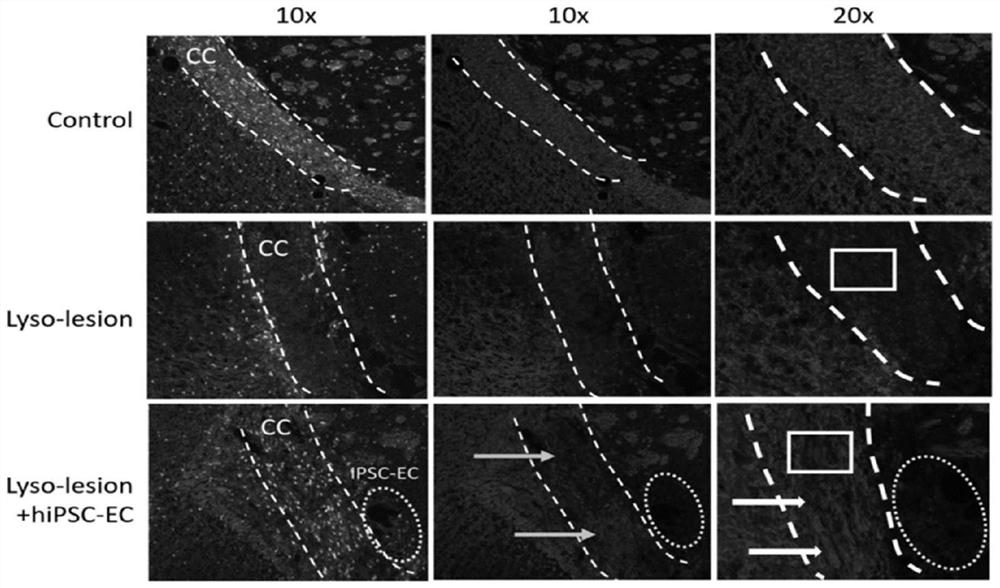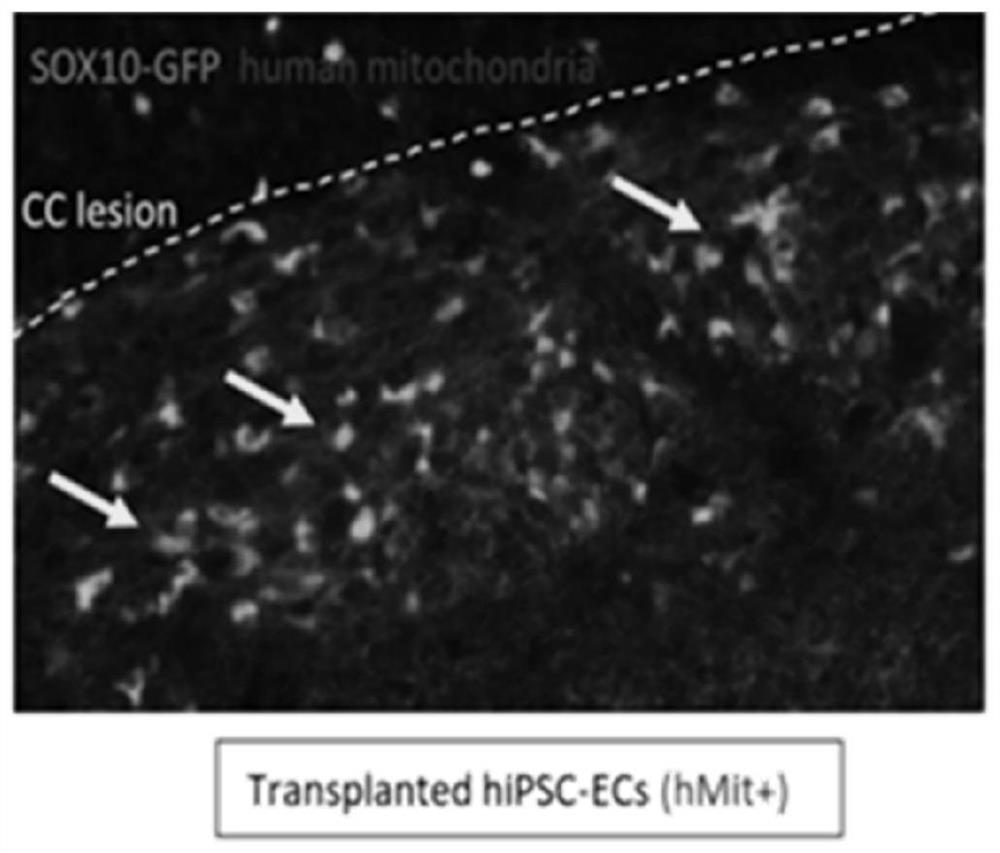Application of endothelial cells and precursor cells thereof in treatment of demyelination diseases
A demyelinating disease and precursor cell technology, applied to the application field of endothelial cells and their precursor cells in the treatment of demyelinating diseases, can solve problems such as large side effects and ineffective myelin repair
- Summary
- Abstract
- Description
- Claims
- Application Information
AI Technical Summary
Problems solved by technology
Method used
Image
Examples
Embodiment 1
[0098] Example 1 Effect of hiPSC-EC transplantation on myelination
[0099] 1. Establishing a mouse model of nerve demyelination
[0100] 1% lysoletinin (Lyso) was directly injected into the mouse corpus callosum (CC) site to cause nerve demyelination (injection model diagram see figure 1 A), specific method references (A new EAE model of braindemyelination induced by intracerebroventricular pertussis toxin. Biochem Biophys Res Commun. 2008 May 23; 370(1): 16-21). Simultaneous use of cyclosporine to prevent xenogeneic rejection.
[0101] 2. Induced differentiation from iPSCs to form EPC / EC cells
[0102] Steps: using patented technology (see publication number: CN108384746B, patent name: a method for efficient differentiation of induced pluripotent stem cells into mature endothelial cells), induce differentiation of iPSCs to form EPC / EC cells.
[0103] 3. Detection of BDNF secreted by EPCs induced by iPSCs
[0104] Steps: EPCs induced by iPSCs were fixed with 4% paraformal...
Embodiment 2
[0111] Example 2 Effect of hiPSC-EC transplantation on nerve remyelination and axon repair
[0112] To evaluate the effect of hiPSC-EC (EC derived from human induced pluripotent stem cells) transplantation on neuronal protection against demyelination-induced axonal injury, axons from the demyelinated area of corpus callosum (CC) were treated with NF200 mark. hiPSC-EC transplantation effectively increased the staining intensity of NF200 markers (using FujiIntDen to count the fluorescence intensity, 0.82 in the hiPSC-EC group was higher than 0.24 in the control group, p<0.05), and the NF200+ fiber structure was clearer, implying neuroprotection or rapid recovery . This axonal protection is associated with myelin lipid protection / remyelination promoted by iPSC-EC transplantation. Note: The control group was injected with the same volume of vehicle (i.e. PBS solution) as the hiPSC-EC group in the same way.
Embodiment 3
[0113] Example 3 Effect of hiPSC-EC transplantation on recruiting OPC enrichment
[0114] 1. Steps
[0115] 1% lysoletinin (Lyso) was directly injected into the mouse corpus callosum (CC) site to cause nerve demyelination, the specific method reference (A new EAE model of brain demyelination induced by intracerebral pertussis toxin.Biochem Biophys Res Commun.2008May23; 370 (1):16-21). Simultaneous use of cyclosporine to prevent xenogeneic rejection. After 3 days of modeling, hiPSC-ECs were transplanted in the injured area, and the enrichment of OPCs in the injured area was observed 8 days later. In order to better observe the enrichment of endogenous OPC, the above experiment was carried out using a mouse strain carrying the SOX10-GFP reporter gene (a gift from Professor W. Richardson of UCL University, UK).
[0116] 2. Results
[0117] The results showed that OPC enrichment could be seen in the injured area after transplantation ( image 3 ).
PUM
 Login to View More
Login to View More Abstract
Description
Claims
Application Information
 Login to View More
Login to View More - R&D
- Intellectual Property
- Life Sciences
- Materials
- Tech Scout
- Unparalleled Data Quality
- Higher Quality Content
- 60% Fewer Hallucinations
Browse by: Latest US Patents, China's latest patents, Technical Efficacy Thesaurus, Application Domain, Technology Topic, Popular Technical Reports.
© 2025 PatSnap. All rights reserved.Legal|Privacy policy|Modern Slavery Act Transparency Statement|Sitemap|About US| Contact US: help@patsnap.com



